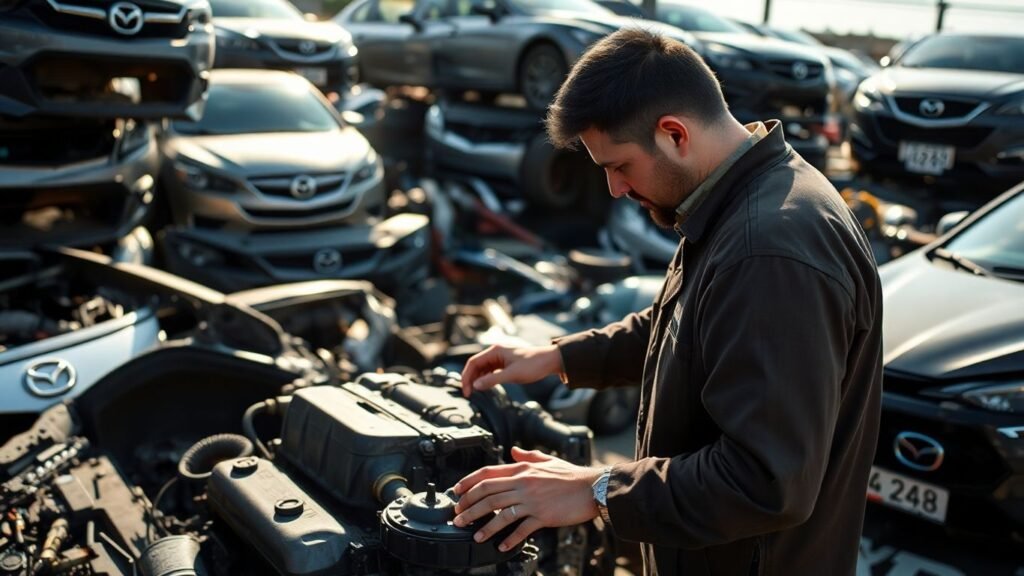Ever wondered what happens to a Mazda after it’s seen better days? It’s not just junked. For Mazda wreckers, it’s the start of a busy day focused on salvaging and giving parts a new life. We’re going behind the scenes to see how it all works.
Key Takeaways
- Mazda wreckers start by taking in vehicles, preparing them for breakdown.
- They carefully remove usable parts like engines, body panels, and tires.
- Eco-friendly methods are used, including draining fluids and recycling materials.
- Salvaged parts are sold to keep repair costs down for owners.
- Some cars are fixed up and resold, extending their usefulness.
A Day in the Life of Mazda Wreckers: Behind the Scenes
When a Mazda arrives at our yard, it’s not the end of its story, but the beginning of a new chapter. Our process starts the moment the vehicle is towed in. We don’t just see a pile of metal; we see potential. The first step is a thorough inspection to figure out what’s salvageable. Some cars are in surprisingly good shape, needing only minor fixes before they can be offered for resale. Others are brought in specifically for their parts.
From Driveway to Dismantling: The Initial Intake
Every vehicle that comes through our gates has a history, and our job is to assess that history quickly. We check the VIN, look over the general condition, and make a note of any obvious damage or missing pieces. This initial assessment helps us decide the best path forward for each car – whether it’s a candidate for a quick refurbish or destined for parts harvesting. It’s a bit like a doctor giving a patient a preliminary check-up before deciding on a treatment plan.
Identifying Usable Components
This is where the real detective work begins. Our experienced team knows Mazdas inside and out. They can spot a perfectly good alternator or a set of undamaged headlights from across the yard. We look for parts that meet our quality standards, meaning they’re functional and have plenty of life left. It’s not just about pulling parts; it’s about identifying the right parts that someone will actually need and that will perform reliably.
The Art of Careful Part Removal
Once a part is identified as usable, the careful extraction process begins. This isn’t a job for a sledgehammer. We use specialized tools to remove components like engines, transmissions, doors, and even intricate electronics without causing further damage. Precision is key here, as even a small nick can render a part unusable. We treat each car with respect, understanding that its components are destined for another Mazda, potentially saving another owner a lot of money and hassle.
Salvaging Precious Mazda Components

Once a Mazda makes its way to the wrecking yard, the real work of salvaging begins. It’s not just about tossing parts aside; it’s a careful process to pull out anything that still has some life left in it. We’re talking about the bits and pieces that can save someone else a lot of money on repairs.
Engines and Transmissions: Rebuilding for Resale
These are the big ticket items, for sure. When an engine or transmission comes out, we give it a good look-over. If it seems solid, we might do some basic checks, maybe swap out a worn seal or two. The goal is to get these major components ready for a second life, often saving owners thousands compared to buying new. It’s pretty satisfying to know a good engine can keep another Mazda running smoothly on the road.
Body Panels and Glass: Restoring Aesthetics
Got a dented fender or a cracked window? We’ve got you covered. Body panels like doors, hoods, and fenders are often in decent shape, even on cars that have seen better days. We’ll remove them carefully, check for rust or major damage, and get them cleaned up. Same goes for windows and mirrors. It’s amazing how a good used door can make a car look whole again.
Tires and Rims: Giving Wheels a Second Chance
Even if the tires themselves are worn out, the rims they’re attached to might be perfectly fine. We’ll often separate the tires from the rims. The rims get cleaned and inspected for bends or cracks. Good used tires, even with some miles left, can be a lifesaver for someone who needs to get their car inspected or just needs a temporary replacement. It’s all about providing affordable options.
Eco-Friendly Practices in Mazda Wrecking
Responsible Fluid Drainage
When a Mazda comes to our yard, the first thing we do is handle all the fluids. Think oil, coolant, brake fluid – the stuff that can really mess up the ground if it leaks out. We drain it all carefully into special containers. This stops any contamination of the soil or water. It’s a pretty straightforward process, but it’s super important for keeping the environment clean. We have specific procedures for each type of fluid to make sure it’s disposed of or recycled properly.
Recycling Metals and Plastics
After the fluids are out and the usable parts are salvaged, we’re left with the car’s shell and other bits. Most of this is metal, like steel and aluminum, and some plastic. These materials get sorted and sent off to be recycled. The metal can be melted down and used to make new car parts, appliances, or even building materials. It’s amazing how much of an old car can get a new life this way. We try to separate as much as possible to make the recycling process more efficient.
Minimizing Environmental Impact
Our whole operation is geared towards reducing waste and pollution. By salvaging parts, we help keep repair costs down for other Mazda owners and stop perfectly good components from ending up in a landfill. Even the stuff that can’t be reused gets processed responsibly. We aim to give every vehicle that comes through our yard a second chance, whether it’s through reselling parts, refurbishing a whole car, or recycling its materials. It’s about making sure that when a Mazda reaches the end of its road with one owner, it doesn’t become a burden on the planet.
We’re not just taking cars apart; we’re actively participating in a cycle that benefits everyone. It’s about being smart with resources and thinking about the bigger picture. Every little bit counts when it comes to protecting the environment, and that’s what we focus on every day.
The Resale Market for Mazda Parts
Connecting Buyers with Quality Used Parts
So, you’ve got a Mazda that needs a specific part, but buying brand new is just too much. That’s where we come in. We take perfectly good components from cars that aren’t running anymore and get them ready for someone else to use. Think engines, transmissions, alternators, even those little interior trim pieces. We clean them up, test them out, and make sure they’re ready to go. It’s a smart way to get your car back on the road without breaking the bank.
Keeping Repair Costs Affordable
Buying used parts makes a big difference for people trying to fix their cars. Instead of shelling out hundreds or even thousands for a new part, you can often get a quality used one for a fraction of the price. This means more people can afford to keep their Mazdas running, which is good for everyone. It’s not just about saving money; it’s about making car ownership more accessible.
Extending the Lifespan of Mazda Vehicles
When we salvage parts, we’re not just selling bits and pieces; we’re helping to keep older Mazdas on the road longer. A lot of these cars still have plenty of life left in them, but one or two broken parts can make them unusable. By providing affordable replacement parts, we give these vehicles a second chance. It’s a win-win: the car gets fixed, and another vehicle doesn’t end up as scrap metal prematurely. It’s a pretty neat cycle, really.
| Part Category | Typical Condition | Resale Focus |
|---|---|---|
| Engines & Transmissions | Tested, Cleaned | Rebuilt or low-mileage units |
| Body Panels | Minor Imperfections | Straight panels, good paint match potential |
| Electrical Components | Tested | Alternators, starters, sensors |
| Interior Parts | Good Condition | Seats, dashboards, door panels |
Beyond Parts: Vehicle Restoration Possibilities
Assessing Cars for Refurbishment
Sometimes, a Mazda that rolls onto the lot isn’t just a source of parts; it’s a candidate for a whole new life. We look at cars that might have a bit more potential than just being stripped down. It’s about spotting the ones that, with a little work, could be back on the road. We check the frame, the basic structure, and see if the major systems are salvageable without costing a fortune to fix. It’s a bit like looking at an old house – you can tell if it’s got good bones.
Minor Repairs for Resale
If a car passes the initial assessment, we might decide to do some light repairs. This could mean fixing a dented fender, replacing a cracked windshield, or sorting out some minor electrical issues. We’re not talking about full restorations here, but rather getting a vehicle into a presentable and safe condition for someone else to buy. It’s a way to add more value than just selling individual parts.
| Repair Type | Example Work |
|---|---|
| Bodywork | Dent removal, minor rust repair |
| Glass Replacement | Windshields, side windows |
| Mechanical | Brake adjustments, fluid changes |
| Electrical | Headlight/taillight fixes |
It’s surprising how many cars can be given a second chance with just a few focused repairs. We aim to make them reliable enough for someone to drive away with confidence.
Giving Cars a New Lease on Life
Ultimately, this process is about extending the usefulness of a vehicle. Instead of ending up as scrap metal, some Mazdas get a chance to serve another owner. It’s a good feeling knowing that a car we salvaged can still be a dependable mode of transport for someone, and it’s a smart choice for buyers looking for a more affordable option than a brand-new car.
The Final Stages: Scrap Metal Processing

Processing Remaining Car Shells
After all the good parts are pulled, what’s left of the Mazda is basically a metal skeleton. This shell, though no longer a car, is still packed with useful materials. We’re talking steel, aluminum, and other metals that have a whole new life waiting for them. These car bodies get sent off to specialized facilities where they’re processed.
Valuable Materials for New Products
Think about it: that old Mazda’s frame is mostly steel. Steel is incredibly recyclable. It gets shredded, melted down, and then reformed into all sorts of new things. It could be part of a new car, a washing machine, or even building materials. It’s pretty neat how something that’s completely done as a car can become the building blocks for something else entirely. The aluminum from the engine block or body panels gets the same treatment.
| Material | Typical Recycled Use |
|---|---|
| Steel | New car frames, appliances, construction beams |
| Aluminum | New car parts, cans, window frames |
| Copper | Wiring, plumbing pipes |
The Cycle of Automotive Recycling
It really closes the loop, doesn’t it? We take a car, salvage what we can to keep other Mazdas on the road affordably, and then the rest gets recycled. This whole process means less raw material needs to be mined and manufactured from scratch, which saves a lot of energy and reduces pollution. It’s a responsible way to handle vehicles that have reached the end of their road-going days.
Wrapping It Up
So, that’s pretty much the deal with Mazda wreckers. It’s not just about tearing cars apart; it’s about giving useful bits a new home and keeping good parts out of the trash. When you think about it, these places are kind of like recycling centers for cars. They take what’s left, pull out anything that can still be used – like engines or doors – and then the rest gets processed. It’s a whole system that helps other people fix their cars without spending a fortune, and it stops perfectly good metal from just sitting around. Pretty neat, right?








